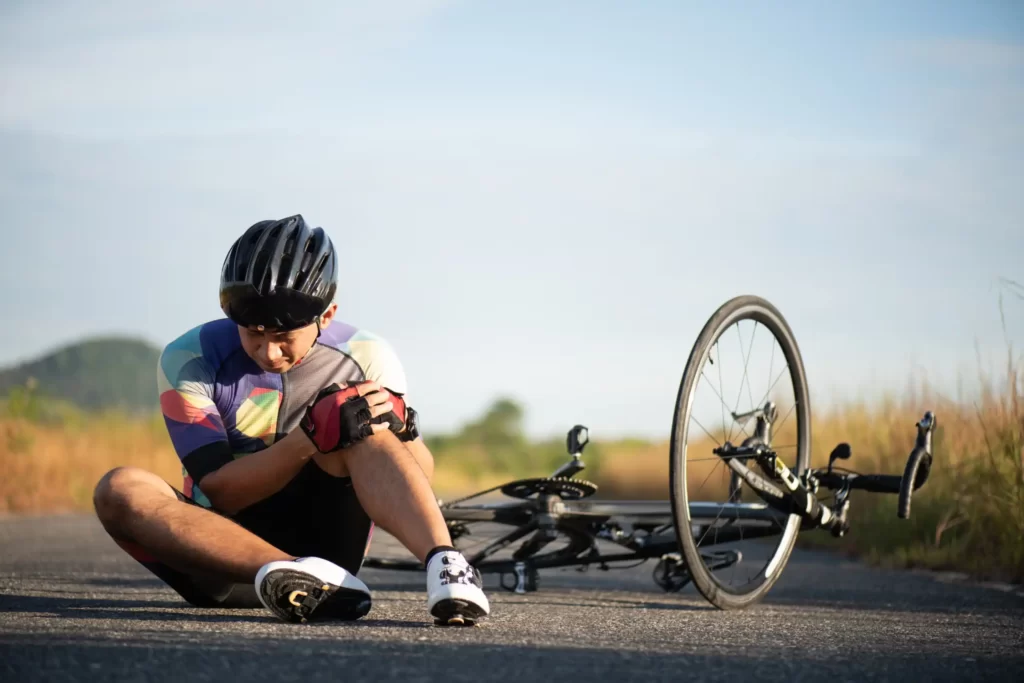Mastering the Ride: A Guide to Dealing with Common Cycling Injuries
Cycling is a fascinating and enjoyable sport that improves both physical and mental health. Cycling does come with risks that are just like any other sport. Bike cyclists are not immune from the risk of harm, from a few scratches to more serious accidents. So in this article, we’ll go over helpful tips on preventing injuries and dealing with typical problems that occur due to bike accidents. Let’s go.
How Can You Prevent Injury While Cycling?

Proper Bike Fit: Ensuring your bike is correctly fitted to your body can significantly reduce the risk of injuries. An improper fit may lead to discomfort, fatigue, and increased vulnerability to accidents.
The Right Gear for the Right Ride: One of the most effective ways to prevent cycling injuries is to invest in the appropriate gear. Wearing a well-fitted helmet is non-negotiable, as it provides essential protection for your head in case of a bike accident. Additionally, don’t forget about padded gloves, reflective clothing, and sunglasses to shield your eyes from dust, wind, and debris.
Warm-Up Exercises: Incorporate warm-up exercises to prepare your muscles and joints for the demands of cycling.
Regular Maintenance: Keep your bike in good condition. Check brakes, tires, and other components regularly to avoid mechanical failures that could lead to accidents.
Listen to Your Body: Ignoring small injuries can often lead to more substantial problems down the road. Pay close attention to any discomfort or pain you may feel while cycling, even if it seems minor. Take adequate rest, apply ice or heat to the affected area, and consider consulting a healthcare professional. Taking immediate action can prevent small issues from evolving into long-term problems.

Dealing with Common Cycling Injuries
While we strive to prevent accidents, understanding how to address common cycling injuries is essential for maintaining a safe and enjoyable riding experience. Here are a few common cycling injuries and how to deal with them:
1_Road rash:
Road rash is a common minor injury that happens when the skin scratches the road surface after a fall.
How to deal with it?
- Clean the affected area gently with alcohol and water.
- Apply an antibiotic ointment to prevent infection.
- Cover the road rash with a sterile bandage or non-stick dressing.
2_Sprains and strains:
Sprains involve stretched or torn ligaments, while strains affect muscles or tendons. Common in falls or sudden twists.
How to deal with it?
- Rest the injured area.
- Apply ice to reduce swelling.
- Use compression bandages for support.
- Elevate the injured limb to minimize swelling.
3_Bruising and muscle soreness:
Are typical injuries while riding a bike and include pain in muscles such as the knee, ankle, wrist, and back, among others.
How to deal with it?
- Allow the affected muscles to rest.
- Apply a cold compress to the bruised or sore area for 15-20 minutes to reduce swelling and promote recovery.
- To lessen swelling and improve in healing, use warm compresses or warm baths after the first 48 hours.
- If pain or soreness persists or worsens, consult with a healthcare professional.
4_Overuse Injuries:
Overuse injuries, such as tendonitis or stress fractures, can occur gradually with repetitive motion.
How to deal with it?
- Rest and avoid the activity causing the overuse.
- Apply ice to reduce inflammation.
- Consult with a healthcare professional for a comprehensive treatment plan.
5_Fractures:
Fractures can result from high-impact crashes, often involving the collarbone or wrist.
How to deal with it?
- Immobilize the injured limb using a splint or brace.
- Apply a cold compress to reduce swelling.
- Seek immediate medical attention for X-rays and professional assessment.
6_Concussions:
Head injuries, even when wearing a helmet, can lead to concussions. Symptoms include dizziness, confusion, and nausea.
How to deal with it?
- Seek medical attention immediately.
- Rest and avoid stimulating activities until fully recovered.
- Gradually reintroduce physical activity under medical guidance.
7_Dislocations:
Dislocations happen when bones are forced out of their normal positions, often occurring in the shoulders or joints.
How to deal with it?
- Do not attempt to pop the joint back in yourself.
- Immobilize the affected area.
- Seek prompt medical attention for professional relocation.

Cycling Accident Injuries: A Comprehensive Approach

In the unfortunate event that a bicycle accident causes more serious injuries, it’s critical to adopt the following thorough strategy:
Emergency Response: Call for help immediately. Administer first aid as necessary while waiting for emergency services.
Medical Evaluation: To determine the level of damage and choose the best plan of action, have a comprehensive medical examination.
Rehabilitation: Adhere to the doctor’s advice for recovery, which could involve a phased return to riding and physical therapy.

In conclusion, it can be said that cycling is an enjoyable and beneficial physical activity, but it also comes with risks that require caution and preventive measures. To avoid common injuries, it is advisable to get bike fittings to properly adjust the seat and handlebars and wear protective accessories such as a helmet and gloves. Additionally, warm-up exercises and regular bike maintenance are crucial aspects.
If an injury occurs, it’s important to handle it with care. Cleaning wounds, applying the appropriate antibiotic ointment, and providing necessary care for affected muscles and joints can contribute to a speedy recovery. In cases of severe injuries, seeking immediate medical attention and following the guidance of healthcare professionals for rehabilitation is essential.
Ultimately, maintaining caution and taking preventive measures is fundamental to enjoying safe and healthy cycling.






